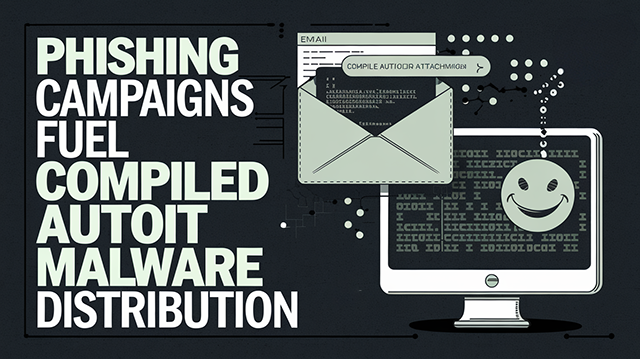Phishing Campaigns Fuel Compiled AutoIt Malware Distribution

Threat Group: Various (including XLoader, SnakeKeylogger, RedLine, AgentTesla, RemcosRAT)
Threat Type: Multi-Functional Malware via Phishing Campaigns
Exploited Vulnerabilities: None specific; relies on social engineering for initial infection
Malware Used: AutoIt Compile Malware (XLoader, SnakeKeylogger, RedLine, AgentTesla, RemcosRAT)
Threat Score: High (8.7/10) – Due to the rapid increase in distribution and ease of execution through phishing emails
Last Threat Observation: January 10, 2025
Overview
The distribution of malware compiled using the AutoIt scripting language has seen a rapid increase, particularly through phishing email campaigns. AhnLab Security Intelligence Center (ASEC) tracks these campaigns weekly and has observed a sharp surge in AutoIt malware distribution since August 2024, nearly matching .NET malware prevalence by December.
The increasing popularity of AutoIt among threat actors stems from its simplicity, low dependency requirements, and straightforward compilation into executable files. Recent campaigns have utilized AutoIt to distribute a variety of malware strains, including XLoader, SnakeKeylogger, RedLine Stealer, AgentTesla, and RemcosRAT.
Key Details
- Delivery Method: Malicious attachments in phishing emails containing AutoIt-compiled executables.
- Target: Individual users and organizations, primarily aimed at credential theft and data exfiltration.
- Functions:
- Credential theft from browsers, email clients, and clipboard.
- Remote control and monitoring through RAT functionality.
- Cryptomining operations.
- Enhanced evasion techniques.
- Obfuscation: Utilizes encrypted scripts embedded in the compiled EXE files, making detection difficult.
Attack Vectors
Phishing emails remain the primary method for distributing AutoIt malware. These emails often include malicious attachments disguised as legitimate documents or executables. Upon execution, the AutoIt script decrypts and runs the embedded payload, initiating the malware's malicious functions.
Key Distribution Trends:
- Increased AutoIt Distribution: Since August 2024, the share of AutoIt malware has grown significantly, rivaling .NET malware in prevalence by December.
- Ease of Use: AutoIt simplifies the process of malware development and reduces environmental dependencies.
- Phishing Campaigns: Phishing emails distributing AutoIt malware often use social engineering to target users, luring them to open malicious attachments.
Indicators of Compromise (IoCs)
FileHash-MD5
- 001c439ef3941045f1d139d2172fc922
- 0084fa11e77425fd332e10928312f760
- 013eddd3584c1bebdff3e5efc99ef3d7
- 0154fe9c5f4ad81beeedcf4fdb397ed4
- 02371e83603c6f0718c1297bb9c92139
FileHash-SHA1
- 33de149315ca65380f3f4f39ac3dcb85e36f588d
- 939c3757ae0f62cda2ef34935d34f3ac70bba776
- a8c28b230cd5970df75d0db657285f4338778640
FileHash-SHA256
- 0d76a185c479321a6eb599b67de8126eb81d5e3f8a1b9d93c0abaeeef9c89e40
- 17a478564c4eb41b217ae131ab1b433278bb60bd0d4b0f876f602d71336abae3
- f8c3f6b1795091d7211dc5b0d508c9ffa115e6fbbab18b4ee9545b2124e211e5
Mitigation and Prevention
- User Awareness: Educate employees and users about phishing tactics and the dangers of opening unsolicited attachments.
- Email Filtering: Use advanced email filters to detect and block malicious attachments.
- Endpoint Protection: Deploy antivirus solutions capable of detecting AutoIt-compiled executables and unusual process activities.
- Log Monitoring: Regularly monitor system and network logs for signs of unauthorized activity.
- Software Updates: Ensure operating systems and applications are up-to-date to reduce exploitable vulnerabilities.
- IOCs Monitoring: Implement tools to monitor for known IoCs, including MD5 hashes and network connections to malicious domains.
Risk Assessment
The surge in AutoIt malware distribution reflects its attractiveness to cybercriminals due to its ease of use and adaptability. These campaigns pose significant risks to users and organizations, particularly due to their reliance on phishing emails, which are often difficult to identify without proper training and defenses.
Organizations must prioritize proactive measures to mitigate this threat, including enhanced email security, regular system updates, and user education on phishing techniques.
Conclusion
The shift from .NET to AutoIt malware distribution underscores the need for continuous adaptation in cybersecurity defenses. As attackers refine their techniques, organizations must remain vigilant and deploy robust strategies to prevent infections and protect sensitive data.
Sources:


